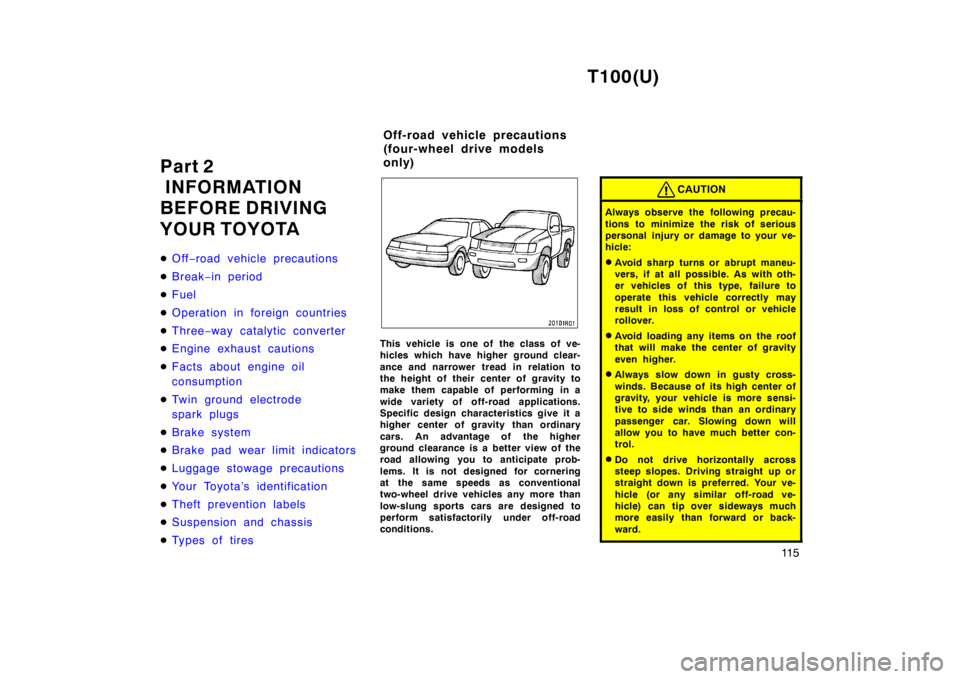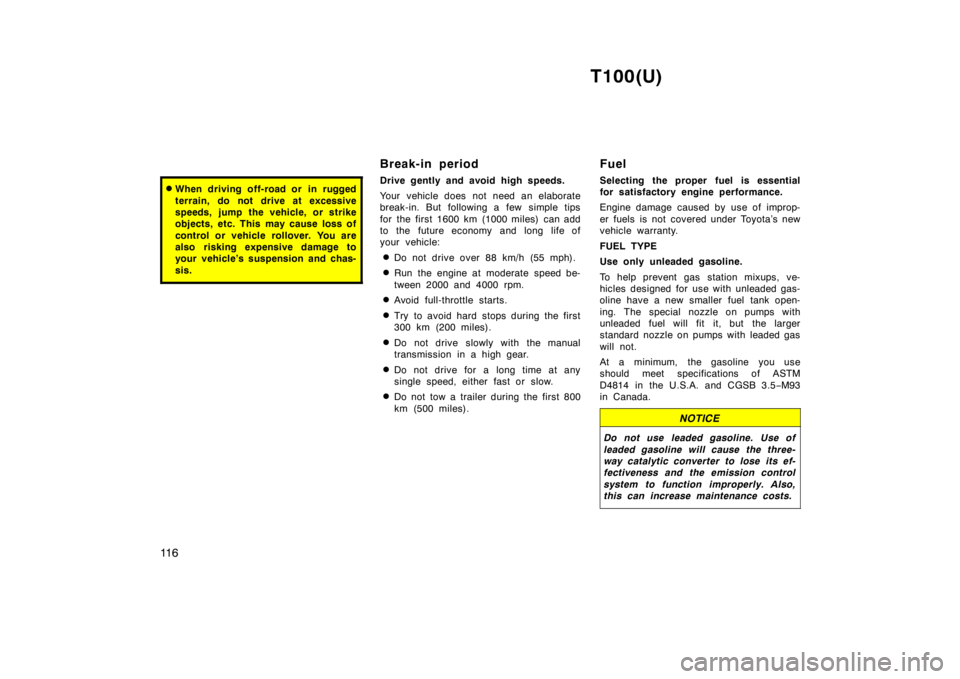1998 TOYOTA T100 fuel
[x] Cancel search: fuelPage 60 of 214

T100(U)
60
Vo l t m e t e r
The voltmeter tells whether the battery
is charged or discharged. Check it
while the engine is running—the needle
should always indicate as shown above.
If the needle reads below or above the
normal range while the engine is running,
it indicates the charging system needs im-
mediate repair.
However, it is normal for the needle to
drop below the normal range during en-
gine starting.
TachometerThe tachometer indicates engine speed
in thousands of rpm (revolutions per
minute). Use it while driving to select
correct shift points and to prevent en-
gine lugging and overfeeding.
Driving with the engine running too fast
causes excessive engine wear and poor
fuel economy. Remember, in most cases
the slower the engine speed, the greater
the fuel economy.
NOTICE
Do not let the indicator needle get
into the red zone. This may cause
severe engine damage.
Odometer and trip meter
The odometer records the total distance
the vehicle has been driven. The trip
meter may be set to zero to record the
distance on each trip. To reset the trip
meter, press the trip meter reset knob.
The black digits on white indicate tenths
of kilometers or miles.
Page 61 of 214

T100(U)61
If the indicator or Do this.
buzzer comes on...
(a) If parking brake is off,stop and check.
(b) Fasten seat belts.
(c) Stop and check.
(d) Stop and check.
(e) Fill up tank.
(f) Take vehicle to Toyota dealer.
(Indicator and buzzer)
Low fuel level
warning light
(type B)(type A)
10302
(h) Take vehicle toTo y o t ad ealer
immediately.
If the indicator or Do this.
buzzer comes on...
(g)
Take vehicle to
(type A) Toyota dealer.
(i) Light reminder Turn off lights. buzzer
(j) Key reminder Remove key.
buzzer
(type B)
(k) Shift four-wheel drive
control out of
”N”. 10302
If the indicator or Do this.
buzzer comes on...
(l) Stop and check.
(m) Add washer fluid.
10302
Service reminder indicators
an d warn in g bu zzers
Page 63 of 214

T100(U)63
NOTICE
Do not drive the vehicle with the
warning light on—even for one block.
It may ruin the engine.
(e) Low Fuel Level Warning Light
This light comes on when the fuel level
in the tank becomes nearly empty. Fill up
the tank as soon as possible.
On inclines or curves, due to the move-
ment of fuel in the tank, the low fuel level
warning light may come on earlier than
usual.
(f) Malfunction indicator lamp
This lamp comes on in the following
cases.
a. The fuel tank is completely empty. (See
”Fuel gauge” in Chapter 1−5 for instruc-
tions.)
b. The fuel tank cap is not tightened se-
curely. (See ”Fuel tank cap” in Chapter1 −2 for instructions.)
c. There is a problem somewhere in your
engine or automatic transmission electrical
system. If it comes on while you are driving in
case b, have your vehicle checked/re-
paired by your Toyota dealer as soon as
possible.
(g) ”ABS” Warning Light
This light warns that there is a problem
somewhere in your anti-lock brake system.
If it comes on while you are driving, have
your vehicle checked by your Toyota dealer
as soon as possible.
The light will come on when the ignition
key is turned to the ”ON” position. After
about 3 seconds, the light will go off.
When the ”ABS” warning light is on (and
the brake system warning light is off), the
brake system operates conventionally but
anti
−lock brake system is not assisting
brake performance so that the wheels can
lock −up during sudden braking or braking
on slippery road surfaces.
(h) SRS Airbag Warning Light
This light will come on when the ignition
key is turned to the ”ACC” or ”ON” posi-
tion. After about 6 seconds, the light will
go off. This means the airbag system is
operating properly. The warning light system monitors the
front airbag sensors, center airbag sensor
assembly, inflator, warning light, intercon-
necting wiring and power sources.
If either of the following conditions occurs, this indicates a malfunction somewhere in
the parts monitored by the warning light
system. Contact your Toyota dealer as soon
as possible to service the vehicle.
The light does not come on when the
ignition key is turned to the ”ACC” or
”ON” position or remains on.
The light comes on while driving.
(i) Light Reminder Buzzer
This buzzer will sound if the driver ’s door
is opened while the ignition switch is
turned to the ”LOCK” position with the
headlight switch on. Removing the key will
not stop the buzzer as long as the head-
light switch is on.
(j) Key Reminder Buzzer
This buzzer reminds you to remove the
key when you open the driver’s door with
the ignition key in the ”ACC” or ”LOCK”
position.
Page 64 of 214

T100(U)
64
(k) Unengaged ”Park” Warning Light
(vehicles with automatic transmis-
sion)
This light warns that the transmission
”Park” mechanism is not engaged. If the
four-wheel drive control is in the ”N” posi-
tion while the selector lever is in the ”P”
position, the transmission will disengage
and the wheels will not lock.
CAUTION
To restore the park function, shift the
four-wheel drive control out of ”N”,
or the vehicle can move.
(l) Automatic Transmission Fluid Tem- perature Warning Light
This light warns that the automatic trans-
mission fluid temperature is too high.
If this light comes on while you are driv-
ing, slow down and pull off the road. Stop
the vehicle at a safe place and put the
selector lever in ”P”. With the engine id-
ling, wait until the light goes off. If the
light goes off, you may start the vehicle
again. If the light does not go off, call a
Toyota dealer or qualified repair shop for
assistance. (m) Low Windshield Washer Fluid Level
Warning Light
The light warns that the windshield washer
fluid level is too low. Add washer fluid at
your earliest opportunity. (For instructions,
see ”Adding washer fluid” in Chapter 7 −3.)
CHECKING SERVICE REMINDER INDICA-
TORS (except the low fuel level warning
light and low windsield washer fluid
level warning light) 1. Apply the parking brake.
2. Turn the ignition key to ”ACC”. The SRS airbag warning light should
come on. It goes off after about 6 se-
conds.
3. Turn the ignition key to ”ON”, but do not start the engine.
All the service reminder indicators ex-
cept the SRS airbag warning light
should come on. The ”ABS” warning
light goes off after about 3 seconds.
If any service reminder indicator or warn-
ing buzzer does not function as described
above, either the bulb is burned out or the
circuit is in need of repair. Have it
checked by your Toyota dealer as soon as
possible.
Page 67 of 214

T100(U)67
Your automatic transmission has a shift
lock system to minimize the possibility of
incorrect operation. This means you can
only shift out of ”P” position when the
brake pedal is depressed (with the ignition
switch in ”ON” position and selector lever
pulled toward you).
(a) Normal driving
1. Start the engine as instructed in ”How to start the engine” in Part 3. The
transmission must be in ”P” or ”N”.
2. With your foot holding down the brake pedal, shift the selector lever to ”D”.
In ”D” position, the automatic transmission
system will select the most suitable gear
for running conditions such as normal
cruising, hill climbing, hard towing, etc.
Always turn the overdrive switch on for
better fuel economy and quieter driving.
Two-wheel drive models–If the engine
coolant temperature is low, the transmis-
sion will not shift into the overdrive gear
even with the overdrive switch on. Four-wheel drive models–If the engine
coolant temperature is low and the vehicle
is travelling at low speed or when the
four-wheel drive control lever is in ”L4”
(four-wheel drive, low range), the trans-
mission will not shift into the overdrive
gear even with the overdrive switch on.
(See ”Four-wheel drive system” in this
Chapter for information of the four-wheel
drive control lever.)
CAUTION
Never put your foot on the accelera-
tor pedal while shifting.
3. Release the parking brake and brake
pedal. Depress the accelerator pedal
slowly for smooth starting.
(b) Using engine braking
To use engine braking, you can downshift
the transmission as follows: � Turn off the overdrive switch. The ”O/D
OFF” indicator light will come on and
the transmission will downshift to the
third gear. �
Shift into the ”2” position. The trans-
mission will downshift to the second
gear when the vehicle speed drops
down to or lower than the following
speed, and more powerful engine brak-
ing will be obtained.
Tw o −wheel drive models—
3RZ −FE engine.....112 km/h (70 mph)
5VZ −FE engine.....117 km/h (73 mph)
Four −wheel drive models—
—Four −wheel drive control lever
in ”H2” and ”H4”.....112 km/h (70 mph)
—Four −wheel drive control lever
in ”L4”.....38 km/h (24 mph)
� Shift into the ”L” position. The trans-
mission will downshift to the first gear
When the vehicle speed drops down to
or lower than the following speed, and
maximum engine braking will be ap-
plied.
Tw o −wheel drive models—
3RZ −FE engine.....54 km/h (34 mph)
5VZ −FE engine.....56 km/h (35 mph)
Four −wheel drive models—
—Four −wheel drive control lever
in ”H2” and ”H4”.....54 km/h (34 mph)
—Four −wheel drive control lever
in ”L4”.....10 km/h (6 mph)
Page 70 of 214

T100(U)
70
Manual transmission
The shift pattern is conventional as
shown above.
Press the clutch pedal down fully while
shifting, and then release it slowly. Do not
rest your foot on the pedal while driving,
because it will cause clutch trouble. And
do not use the clutch to hold the vehicle
when stopped on an uphill grade–use the
parking brake.
Recommended shifting speeds
The transmission is fully synchronized and
upshifting or downshifting is easy.
For the best compromise between fuel
economy and vehicle performance, you
should upshift or downshift at the following
speeds:
3RZ
−FE engine
Low altitude
—1219 m (4000 ft) or lower
gear km/h (mph)
1 to 2 or 2 to 1 24/16 �
1
(15/10 �
1
)
2 to 3 or 3 to 2 43/30 �
1
(27/19 �
1
)
3 to 4 or 4 to 3 64/48 �
1
(40/30 �
1
)
4 to 5 or 5 to 4 74 (46)
High altitude
—Higher than 1219 m (4000 ft)
Upshifting
gear km/h (mph)
1 to 2 24 (15)
2 to 3 43/58 �
2
(27/36 �
2
)
3 to 4 64/72 �
2
(40/45 �
2
)
4 to 5 74/85 �
2
(46/53 �
2
)
Downshifting
gear km/h (mph)
2 to 1 24 (15)
3 to 2 43 (27)
4 to 3 64 (40)
5 to 4 74 (46)
� 1:For constant-speed cruise or constant −
speed cruise after deceleration.
� 2:Applicable under heavy acceleration
conditions. 5VZ
−FE engine
gear km/h (mph)
1 to 2 or 2 to 1 24 (15)
2 to 3 or 3 to 2 40 (25)
3 to 4 or 4 to 3 64 (40)
4 to 5 or 5 to 4 72 (45)
Upshifting too soon or downshifting too
late will cause lugging, and possibly ping-
ing. Regularly revving the engine to maxi-
mum speed in each gear will cause ex-
cessive engine wear and high fuel
consumption.
Maximum allowable speeds
To get on a highway or to pass slower
traffic, maximum acceleration may be nec-
essary. Make sure you observe the follow-
ing maximum allowable speeds in each
gear:
Two-wheel drive models 1-ton models
gear km/h (mph)14 0(2 5 )
27 5(4 7 )
3 115 (71)
4 165(103)
Page 115 of 214

T100(U)11 5
Part 2
INFORMATION
BEFORE DRIVING
YOUR TOYOTA �
Off
−road vehicle precautions
�Break −in period
�Fuel
�Operation in foreign countries
�Three −way catalytic converter
�Engine exhaust cautions
�Facts about engine oil
consumption
�Twin ground electrode
spark plugs
�Brake system
�Brake pad wear limit indicators
�Luggage stowage precautions
�Your Toyota’s identification
�Theft prevention labels
�Suspension and chassis
�Types of tires
This vehicle is one of the class of ve-
hicles which have higher ground clear-
ance and narrower tread in relation to
the height of their center of gravity to
make them capable of performing in a
wide variety of off-road applications.
Specific design characteristics give it a
higher center of gravity than ordinary
cars. An advantage of the higher
ground clearance is a better view of the
road allowing you to anticipate prob-
lems. It is not designed for cornering
at the same speeds as conventional
two-wheel drive vehicles any more than
low-slung sports cars are designed to
perform satisfactorily under off-road
conditions.
CAUTION
Always observe the following precau-
tions to minimize the risk of serious
personal injury or damage to your ve-
hicle: � Avoid sharp turns or abrupt maneu-
vers, if at all possible. As with oth-
er vehicles of this type, failure to
operate this vehicle correctly may
result in loss of control or vehicle
rollover.
� Avoid loading any items on the roof
that will make the center of gravity
even higher.
� Always slow down in gusty cross-
winds. Because of its high center of
gravity, your vehicle is more sensi-
tive to side winds than an ordinary
passenger car. Slowing down will
allow you to have much better con-
trol.
� Do not drive horizontally across
steep slopes. Driving straight up or
straight down is preferred. Your ve-
hicle (or any similar off-road ve-
hicle) can tip over sideways much
more easily than forward or back-
ward.
Off-road vehicle pr ecautions
(four-wheel drive models
only)
Page 116 of 214

T100(U)
11 6
� When driving off-road or in rugged
terrain, do not drive at excessive
speeds, jump the vehicle, or strike
objects, etc. This may cause loss of
control or vehicle rollover. You are
also risking expensive damage to
your vehicle’s suspension and chas-
sis.
Break-in period
Drive gently and avoid high speeds.
Your vehicle does not need an elaborate
break-in. But following a few simple tips
for the first 1600 km (1000 miles) can add
to the future economy and long life of
your vehicle:
� Do not drive over 88 km/h (55 mph).
� Run the engine at moderate speed be-
tween 2000 and 4000 rpm.
� Avoid full-throttle starts.
� Try to avoid hard stops during the first
300 km (200 miles).
� Do not drive slowly with the manual
transmission in a high gear.
� Do not drive for a long time at any
single speed, either fast or slow.
� Do not tow a trailer during the first 800
km (500 miles). Fuel
Selecting the proper fuel is essential
for satisfactory engine performance.
Engine damage caused by use of improp-
er fuels is not covered under Toyota’s new
vehicle warranty.
FUEL TYPE
Use only unleaded gasoline.
To help prevent gas station mixups, ve-
hicles designed for use with unleaded gas-
oline have a new smaller fuel tank open-
ing. The special nozzle on pumps with
unleaded fuel will fit it, but the larger
standard nozzle on pumps with leaded gas
will not.
At a minimum, the gasoline you use
should meet specifications of ASTM
D4814 in the U.S.A. and CGSB 3.5
−M93
in Canada.
NOTICE
Do not use leaded gasoline. Use of
leaded gasoline will cause the three-
way catalytic converter to lose its ef-
fectiveness and the emission control
system to function improperly. Also,
this can increase maintenance costs.